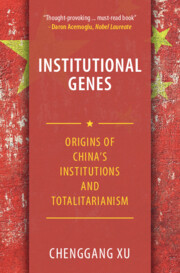Book contents
- Institutional Genes
- Reviews
- Institutional Genes
- Copyright page
- Dedication
- Contents
- Figures
- Preface and Acknowledgments
- Abbreviations
- 1 Introduction
- 2 Institutions and Institutional Genes
- 3 Property Rights as a Form of Institutional Gene
- 4 The Emergence and Evolution of the Institutional Genes of the Chinese Imperial System
- 5 The Imperial Examinations and Confucianism
- 6 The Institutional Genes of Totalitarian Ideology
- 7 Institutional Genes of Totalitarianism
- 8 The Birth of Bolshevik Totalitarianism
- 9 The Failure of Constitutional Reforms and Republican Revolution
- 10 Building China’s Bolshevik Party
- 11 Building a Totalitarian Regime
- 12 Regionally Administered Totalitarianism
- 13 The Post-Mao Reform and Its Cessation
- 14 Conclusion
- References
- Index
11 - Building a Totalitarian Regime
From the Chinese Soviet to the People’s Republic
Published online by Cambridge University Press: 03 June 2025
- Institutional Genes
- Reviews
- Institutional Genes
- Copyright page
- Dedication
- Contents
- Figures
- Preface and Acknowledgments
- Abbreviations
- 1 Introduction
- 2 Institutions and Institutional Genes
- 3 Property Rights as a Form of Institutional Gene
- 4 The Emergence and Evolution of the Institutional Genes of the Chinese Imperial System
- 5 The Imperial Examinations and Confucianism
- 6 The Institutional Genes of Totalitarian Ideology
- 7 Institutional Genes of Totalitarianism
- 8 The Birth of Bolshevik Totalitarianism
- 9 The Failure of Constitutional Reforms and Republican Revolution
- 10 Building China’s Bolshevik Party
- 11 Building a Totalitarian Regime
- 12 Regionally Administered Totalitarianism
- 13 The Post-Mao Reform and Its Cessation
- 14 Conclusion
- References
- Index
Summary
Chapter 11 focuses on the creation, expansion, and operating mechanism of the communist totalitarian regimes in China. Its coverage starts from the first of these regimes, the Chinese Soviet Republic, founded in 1931, up to the founding of the nationwide regime, the People’s Republic of China, and the establishment of a full-fledged classical totalitarian system. The key communist totalitarian strategies were state mobilization and domination, including land reform and the suppression of those deemed to be counterrevolutionaries. The chapter explores the regime’s progression from decentralized to centralized totalitarianism, detailing how power became more concentrated over time. The final section explores the “Sovietization” of the state, describing the construction of a classical totalitarian system, following the Soviet model, which was characterized by strict centralized control and ideological uniformity. This transformation laid the groundwork for the pervasive and enduring nature of the Chinese communist state.
Keywords
Information
- Type
- Chapter
- Information
- Institutional GenesOrigins of China's Institutions and Totalitarianism, pp. 499 - 542Publisher: Cambridge University PressPrint publication year: 2025
